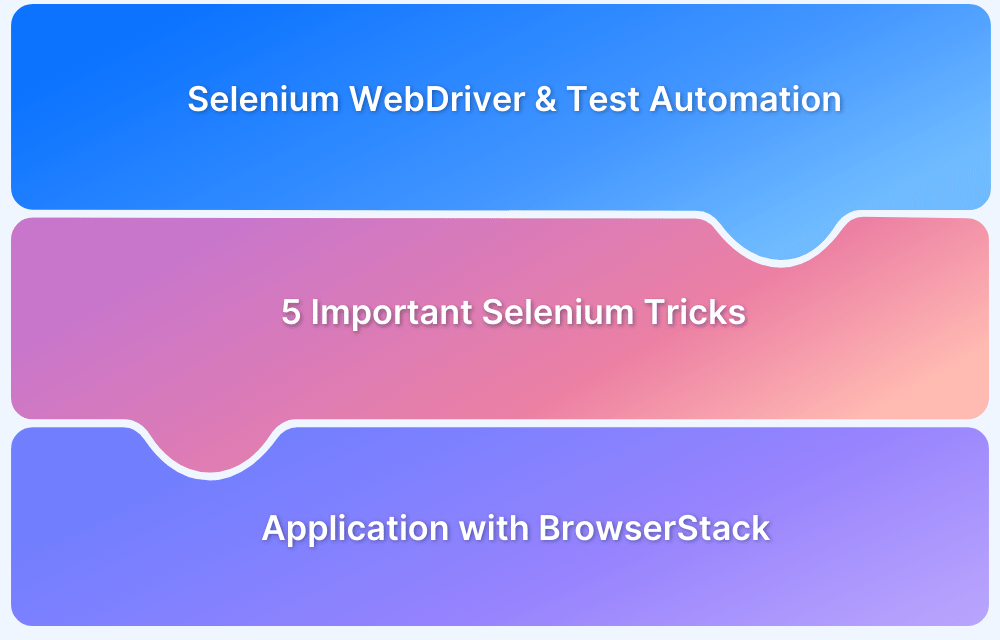Selenium is a popular open-source tool for automating web applications, known for its flexibility and broad language support. However, as testing needs grow, teams often face limitations that affect reliability, scalability, and maintenance.
Overview
Selenium comes with various limitations that can lead to unstable test results, increased maintenance efforts, and reduced testing efficiency for QA and development teams.
Limitations of Selenium Automation
- Limited and complex cross-browser testing setup
- Difficulty in synchronizing events with dynamic web pages
- Frequent false positive and false negative test results
- Poor handling of pop-ups and alerts
- Challenges with dynamic web content and frequently changing elements
- Lack of native support for mobile application testing
- Inability to automate CAPTCHA and OTP workflows
- Limited built-in reporting and analytics
- Slow test execution, especially on large test suites
- Difficulty in reliably handling dynamic web elements
- Minimal error handling and recovery mechanisms
- High maintenance overhead due to frequent UI changes
- No support for Windows-based desktop applications
- Limited support for native mobile applications without third-party tools
- Restricted to testing on desktop browsers only
This article explores the key limitations of Selenium automation, from challenges in handling dynamic web elements to its limited support for mobile and desktop applications.
Limitations of Selenium Automation
While Selenium remains a powerful and widely adopted tool for web automation, it is important to recognize its inherent limitations. These constraints can impact test reliability, increase maintenance efforts, and reduce overall efficiency for QA teams. Understanding these limitations helps teams plan better automation strategies and consider complementary tools when necessary.
Below are some of the key limitations of Selenium automation that teams commonly face:
1. Cross-Browser Testing
Although Selenium supports multiple browsers, setting up and maintaining cross-browser tests can be complex and time-consuming. Each browser requires specific drivers and configurations, and inconsistencies between browser behaviors often lead to flaky or unreliable test results. This adds overhead for QA teams striving to ensure consistent application performance across all supported browsers.
To simplify this process, many teams integrate Selenium with cloud-based platforms like BrowserStack, which offer ready-to-use environments for testing across a wide range of real browsers and devices, reducing setup time and improving test reliability.
2. Synchronizing Events
Selenium often struggles with synchronizing events on modern web pages that use dynamic content loading like AJAX or JavaScript.
Without proper waits or synchronization strategies, tests can fail prematurely or behave inconsistently, causing flaky results that are hard to debug. This forces teams to implement complex explicit or fluent waits, increasing test complexity.
3. False Positive and False Negative Results
Due to timing issues, element instability, or locator failures, Selenium tests may report false positives (passing when they shouldn’t) or false negatives (failing despite correct behavior).
This erodes trust in automation and can lead to wasted time investigating incorrect failures or overlooking actual bugs. Maintaining accurate tests requires continuous script tuning and monitoring.
Read More: Selenium WebElement Commands
4. Handling Pop-Ups
Handling browser pop-ups, alerts, and authentication dialogs is limited and inconsistent in Selenium. Native OS dialogs or complex modal windows often require workarounds or manual intervention, reducing the scope of fully automated testing.
This limitation forces testers to write additional code or pause automation for manual steps, interrupting test flow.
5. Dynamic Web Content
Web applications with frequently changing DOM structures or dynamic elements pose significant challenges for Selenium. Tests can break easily due to changing IDs or element attributes unless robust locator strategies and synchronization techniques are implemented.
This increases maintenance and requires a deeper understanding of the application’s behavior.
6. Mobile Testing
Selenium does not natively support automation of mobile applications, whether native or hybrid. To automate mobile testing, teams need to use tools like Appium, which adds setup complexity and can lead to fragmented test suites. This also increases the learning curve and resource investment for teams focused on cross-platform testing.
BrowserStack integrates with Appium, Espresso, XCUITest, and EarlGrey to offer a cloud-based platform for automated testing of mobile apps on real devices.
7. Captcha
CAPTCHA mechanisms are designed specifically to block automated bots, making them impossible for Selenium to bypass.
Automating workflows that involve CAPTCHA or similar human verification methods usually requires manual intervention or third-party services, which complicates continuous testing processes.
Read More: How to handle Captcha in Selenium
8. Limited Reporting
Selenium lacks built-in, comprehensive reporting features necessary for detailed test result analysis. Without native support, teams must integrate third-party frameworks or custom reporting tools to track test coverage, failures, and trends effectively.
9. Slow Test Execution
Selenium tests often execute slower compared to some modern test automation tools, especially when handling complex UI flows or large test suites. Slow execution impacts continuous integration pipelines and delays feedback to developers, hindering agile development and rapid release cycles.
10. Difficulty in Handling Dynamic Web Elements
Dynamic attributes like changing IDs or classes cause Selenium locators to become unreliable, making element identification challenging. Testers need to design sophisticated locator strategies, such as XPath or CSS selectors with conditions, which increases test script complexity and maintenance overhead.
11. Lack of Error Handling
Selenium offers minimal native error handling or recovery mechanisms within test scripts. When unexpected errors or UI changes occur, tests typically fail immediately without graceful recovery, requiring manual debugging and script fixes. This limits automation resilience and increases downtime.
12. Maintenance Overhead
Due to frequent UI and DOM changes, Selenium test scripts require constant updates to remain functional. This ongoing maintenance consumes significant time and resources, often outweighing the initial automation benefits.
13. Limited Support for Windows-based Applications
Selenium is built for web automation and does not support native Windows desktop applications or other platform-specific software. This limits its use in environments where both web and desktop app testing are needed, forcing teams to use additional tools for full coverage.
14. Limited Support for Mobile Applications
While Selenium can automate mobile web browsers to some extent, it cannot handle native or hybrid apps directly. Teams must adopt complementary frameworks like Appium, increasing the complexity and fragmentation of their automation strategy.
15. Restricted to Only Desktop Browsers Testing
Selenium’s core functionality focuses on desktop browsers, lacking native capabilities for real mobile device testing. While cloud platforms can bridge this gap, relying solely on Selenium restricts the ability to test on diverse device types and real user environments.
Why Use BrowserStack for Automation Testing in Selenium?
To overcome common automation challenges and boost testing efficiency, here are key reasons why BrowserStack is a preferred choice for Selenium automation testing:
- Seamless Selenium Integration: BrowserStack integrates smoothly with Selenium, simplifying automated cross-browser testing without complex local setups.
- Access to Real Browsers and Devices: Provides instant access to a wide range of real browsers and operating systems, enabling tests across hundreds of environments.
- Parallel Test Execution: Supports running tests in parallel on multiple browser-OS combinations, significantly reducing overall test cycle time.
- CI/CD Integration: Easily integrates with popular continuous integration and delivery tools, facilitating automated workflows as part of DevOps pipelines.
- Comprehensive Test Reporting: Offers detailed test reports, video recordings, and logs to quickly identify and debug issues, improving test reliability.
- Eliminates Infrastructure Maintenance: Removes the need for managing local test environments and browser drivers, allowing teams to focus on test development.
- Scalability: BrowserStack’s cloud infrastructure scales effortlessly to meet increasing test demands, supporting large teams and extensive test suites without performance loss.
Conclusion
While Selenium remains a foundational tool for web automation, its inherent limitations, such as challenges with cross-browser testing, dynamic content handling, and maintenance overhead, can impact test reliability and team productivity.
Integrating Selenium with a cloud-based platform like BrowserStack helps overcome many of these hurdles by providing scalable, real-device environments, parallel execution, and robust reporting.
Leveraging BrowserStack alongside Selenium enables teams to build more efficient, reliable automation frameworks that accelerate testing cycles and improve overall software quality.
Frequently Asked Questions
1. What are the limitations of Selenium?
Selenium has the following limitations:
- Limited support for testing desktop applications.
- No built-in reporting mechanism for test results.
- Difficulty in handling dynamic web elements, pop-ups, and dialogs.
- Limited support for touch-enabled devices and gestures.
- Performance limitations for large-scale testing.
- Steep learning curve for beginners.
- Limited ability to handle complex business processes.
- Browser compatibility issues.
- Limited support for image testing.
- Interference with JavaScript alerts and prompts
2. What are the technical limitations of Selenium?
Some of the technical limitations of Selenium are:
- Limited support for testing desktop applications.
- No built-in reporting mechanism for test results.
- Difficulty in handling dynamic web elements, pop-ups, and dialogs.
- Performance limitations for large-scale testing.
- Steep learning curve for beginners.
- Limited ability to handle complex business processes.
- Browser compatibility issues.
- Interference with JavaScript alerts and prompts.
- Limited ability to handle native mobile apps.
- Challenges in testing Captcha and Barcode readers.
- No standardization of test scripting across different programming languages.
- Limited ability to interact with a web page’s low-level components, such as cookies, SSL certificates, and HTTP headers.
3. What is the most difficult problem in Selenium automation?
One of the most difficult problems in Selenium automation is handling dynamic web elements. Dynamic web elements are those that change dynamically, such as pop-ups, dialogs, and drop-down menus. These elements can be challenging to automate as their properties, such as ID, class, and name, can change dynamically, making it difficult to locate them accurately. As a result, the automation scripts may become unreliable and prone to failure. To overcome this challenge, testers often use advanced techniques such as waiting for elements to load, dynamic XPath, and regular expressions.
4. What are the challenges and limitations of Selenium WebDriver?
Some of the challenges and limitations of Selenium WebDriver are:
- Compatibility Issues: Selenium WebDriver may have compatibility issues with certain browsers and their respective versions.
- Handling Dynamic Elements: Dynamic web elements, such as pop-ups, dialogs, and drop-down menus, can be challenging to automate with Selenium WebDriver.
- Performance Limitations: Selenium WebDriver can slow down when automating tests for large-scale applications.
- Steep Learning Curve: Selenium WebDriver has a steep learning curve, and testers need to be familiar with programming concepts and object-oriented programming languages, such as Java or Python, to use it effectively.
- Test Maintenance: Maintaining Selenium WebDriver tests can be time-consuming and complex, especially for large and complex applications.
- Test Stability: Since Selenium is dependent on the browser and its behavior, tests can become unstable and prone to failure when the browser is updated.
- Limited reporting features: Selenium WebDriver does not have built-in reporting features for test results. Testers need to use third-party tools or write custom code to generate test reports.
- Browser compatibility issues: Selenium WebDriver may not work with certain browsers, especially older versions of Internet Explorer.
- Handling HTTPS: Automating HTTPS-secured websites can be challenging with Selenium WebDriver, as it requires a deeper understanding of SSL certificates and browser security.






